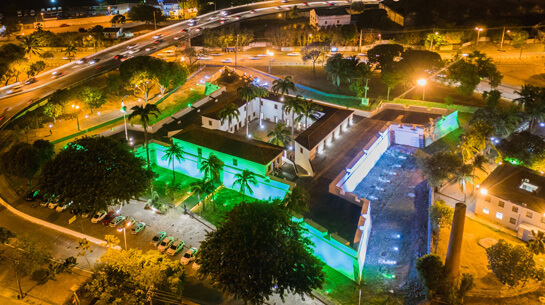- Products and Solutions

Forte das Cinco Pontas houses history and culture in Recife
Although the monument was named after Frederik Hendrik - Prince of Orange - it soon earned the nickname Five Ends Fort because of its pentagonal shape. The most important objectives of the fortress were to guarantee the population the supply of drinking water by protecting the cacimbas (Brazilian name of vital point for the water supply of Recife), and to prevent enemy ships from circulating through the waters of the Capibaribe River and reaching the Barreta dos Afogados (through an existing passage in the reefs) and, from there, escaping with the boats loaded with sugar.
With Recife´s expansion, the fortress lost its defense meaning and began to have new uses: during the eighteenth and nineteenth centuries served as general deposit and prison. At the beginning of the twentieth century, it housed the headquarters of the Quartel General Militar, being listed as a national heritage in 1938. In the late 1970s, the fort underwent another major restructuring to host the facilities of the Recife City Museum, which is located there since 1982.
Forte São Tiago das Cinco Pontas has an internal courtyard, several heavy-grid cells made of iron, and a hidden tunnel designed for the Dutch escape if they were invaded. The building walls, on the other hand, are cut out where the old bronze cannons appear. It is possible to appreciate a beautiful gate at the fortress entrance, all made of hardwood, as well as its doors and windows.
PROJECT THAT VALUES AND PRESERVES
The revitalization promoted by the Neoenergia Institute values the historical importance of the monument. In addition to preserving the artistic and cultural heritage, the newly installed LED lighting system provides energy savings of over 30% compared to the old lighting project. The façade is now illuminated by 66 light projectors that allow the exchange of color shades, enabling the engagement of urban equipment to commemorative and social dates. Ornamental posts installed in the building's garden also received new efficient lamps.
The lighting project delivery of Forte das Cinco Pontas represents the Neoenergia Institute's commitment to Brazilian historical, artistic and cultural values, in line with the worldwide actions developed by the Iberdrola Group Foundations.
News
2025-04-25
Ilumina Social: Instituto Neoenergia lança pela primeira vez edital com foco em saúde e bem-estar
2025-04-22
Neoenergia vende 50% de Itabapoana Transmissão
2025-04-15
Nova campanha da Neoenergia celebra a potência feminina no esporte e reforça apoio às atletas embaixadoras da marca
2025-03-27
Instituto Neoenergia lança chamada inédita unificada de editais para apoiar projetos sociais
2025-03-21
